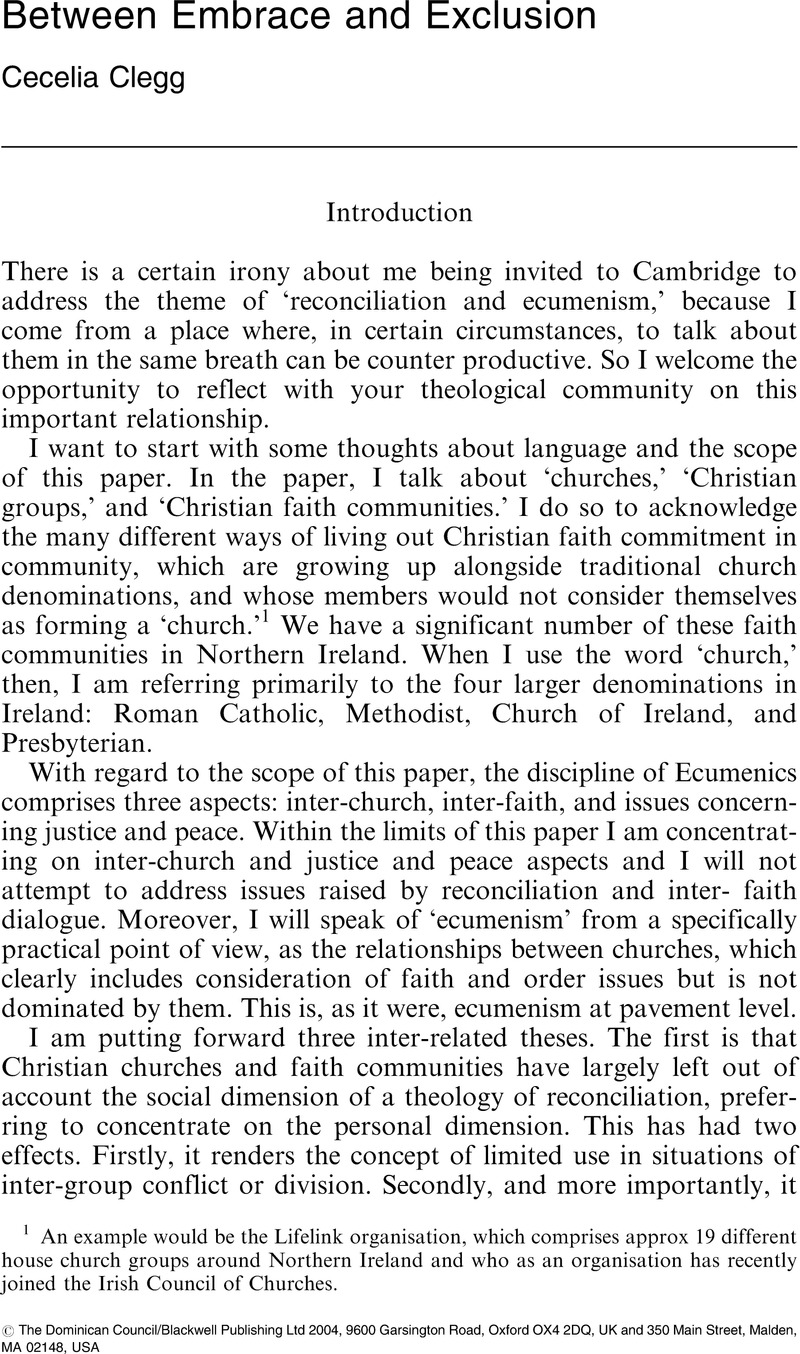No CrossRef data available.
Published online by Cambridge University Press: 01 January 2024

1 An example would be the Lifelink organisation, which comprises approx 19 different house church groups around Northern Ireland and who as an organisation has recently joined the Irish Council of Churches.
2 Volf, Miroslav, Exclusion and Embrace: A Theological Exploration of Identity, Otherness and Reconciliation(Nashville: Abingdon Press), 1996Google Scholar.
3 The project ran from January 1995 to June 2000. The report of the research is available in Liechty, Joseph and Clegg, Cecelia, Moving Beyond Sectarianism: Religion, Conflict, and Reconciliation in Ireland(Dublin: Columba Press), 2001.Google Scholar
4 From the unpublished address with which the late Rev Dr Eric Gallagher launched the Moving Beyond Sectarianism project in Belfast on 3rd April 1995.
5 “And whatever you say, say nothing,” Seamus Heaney, Whatever You Say, Say Nothing, 1975.
6 Volf, Miroslav, “The Social Meaning of Reconciliation,”Interpretation, No54 vol 2 (April 2000), p162–3Google Scholar.
7 Ibid.
8 Ibid. p164–9.
9 Ibid. p163.
10 Ibid. p145–7.
11 Ibid. p167–8.
12 Joseph Liechty and Cecelia Clegg, Moving Beyond Sectarianism, p292.
13 See for example Jürgen Moltmann's Trinitarian theology, which is posited on socially co-constituted, and therefore conscious, rational personhood in Moltmann, Jurgen, “the Social Doctrine of the Trinity,” in Byrne, James. M. ed. The Christian Understanding of God Today: Theological Colloquium on the Occasion of the 400th Anniversary of the Foundation of Trinity College, Dublin (Dublin: Columba Press), 1993Google Scholar; Alistair McFadyen's notion of personhood as socially co-constituted through communication in McFadyen, Alistair, The Call to Personhood: A Christian Theory of the Individual in Social Relationships(Cambridge: University Press), 1990CrossRefGoogle Scholar and Daly, Gabriel, Creation and Redemption(Dublin: Gill and McMillan) 1988Google Scholar.
14 Pannenberg, Wolfhart, Anthropology in a Theological Perspective(Edinburgh: T&T Clark), 1990Google Scholar.
15 See Carl Jung's notion of the ‘transcendent function,’ Jung, Carl Gustav, Collected Works, exec. ed. Maguire, W., trans Hull, R.F.C (London: Routledge & Kegan Paul, 1957 – 1979) Vol 8Google Scholar; and Freud, Sigmund, “The Interpretation of Dreams,”in The Standard Edition of the Complete Psychological Works of Sigmund Freud, trans Strachey, J. (London: Hogarth Press, 1953)Google Scholar, vol IV (I)(1900).
16 Russell, Peter in The Brain Book(London: Routledge & Kegan Paul, 1979)Google Scholar
17 2 Cor 5:19.
18 Cf Jairus’ daughter and the woman with the haemorrhage in Mk 5:21–43 and Matt 9: 18–26.
19 For example his consistently loving choices in the temptations Matt 4: 1–11; and in the agony in Gethsemane Mk 14: 32–42.
20 For the concept of archetypes, see Carl Gustav Jung, Collected Works, Vol 5: 264.
21 Jung believed archetypes to be inherited possibilities, “In the pre-natal phase archetypal images appear no longer connected with the individual's memories but belonging to the stock of inherited possibilities of representation that are born anew in every individual.” Ibid.
22 Rahner, Karl, Theological Investigations, vol 18, trans Quinn, E., (London: Darton, Longman and Todd, 1983), 189–210Google Scholar.
23 This proposition depends upon Carl Jung's concept of the ‘Collective Unconscious.’ Jung's elucidation of this complex concept is scattered through his writings. For an overview: Jung, Carl Gustav, Collected WorksGoogle Scholar, vol 5 and 8.
24 The Nature and Purpose of the Church: A Stage on the Way to a Common Statement, Faith and Order Paper No 181 (Geneva: WCC, 1998) section 26.
25 Miroslav Volf, Exclusion and Embrace, p67.
26 Ibid.
27 cf. the controversy surrounding the text, which accompanied this document and stated that Protestant churches were not be regarded as ‘sister’ churches. Declaration Dominus Iesus: On the Unicity and Salvific Universality of Jesus Christ and the Church(Rome: Congregation for the Doctrine of the Faith, September 2000)
28 See “Report of Faith and Order Commission WCC, Lima, Peru 1982 in Meyer, Harding and Vischer, Lukas, eds. Growth in Agreement: reports and Agreed Statements of Ecumenical Conversations on a World Level(New York: Paulist Press, 1984).Google Scholar